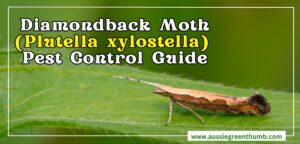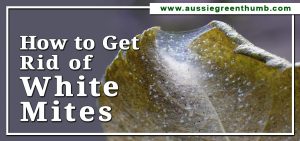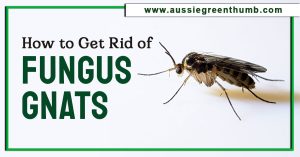Stink bugs are those shield shaped bugs that look incredibly harmless, forage on native plants, emit an odour when provoked and generally keep to themselves. All in all they have very little effect on our daily lives or our gardens yet we’re intent on ridding the planet of these “apparent” nuisances.
More...
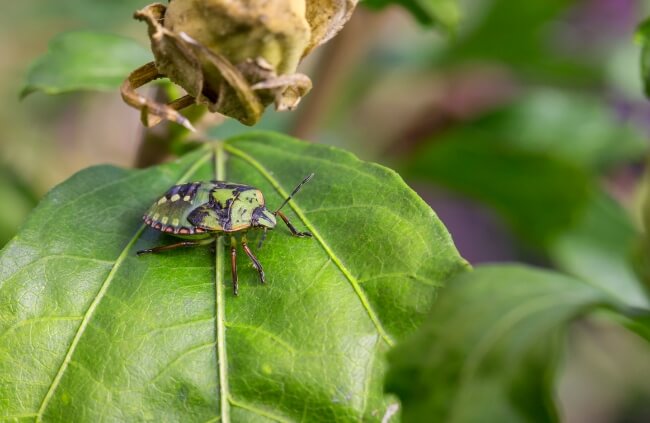
Family: | Pentatomidae |
|---|---|
Common Name: | Shield bugs, stink bugs |
Type: | Winged bugs |
Size: | About 1cm long |
Key features: | Shield shaped body, five stripes on each antenna |
Colour: | Varies (green, brown, black) |
Effects: | Eats plants, spreads infections |
Prevention: | Predators, organic deterrents & pesticides |
Getting to Know Stink Bugs
Stink bug control is a term that could colloquially be ranked with “witch hunt”. It assumes that as gardeners we are intent on removing, or at least managing, the devastating effects of these bugs.
It offers us some solace that if we spread a few chemicals around we’re sure to hit the target and kill every stink bug in the vicinity. While this may be your method of gardening it goes against the grain of natural organic horticulture.
This plant pest have a place in our gardens. As do the praying mantis, Aphidius wasps and even sowbugs. They’re all part of the wider ecological habitat that occurs in our garden with each part playing their part.

What are the Effects of Stink Bugs in the Garden?
So what do this plant pest do? Primarily, they eat. Their favourite food source is native vegetation and they will only move onto exotics if their preferred diet is in short supply, or begins to mature towards the end of the season.
They will sometimes eat fruit but usually they are unable to pierce its protective skin so can only consume those that are already damaged. In other words, they’re very helpful scavengers.
However, there is the reality of the reproducing stink bug. Control in this area is possibly one that needs attention, especially if you live in warmer areas where the stink bugs have the possibility of laying two egg deposits.
Each deposit consists of hundreds of eggs and unless there are some natural predators available they can grow quite rapidly into plague proportions. Therefore stink bug control is all about encouraging their natural predators into the garden – mainly local bird species.
Stink Bugs on Citrus
There are about 600 species of stink bug, in various genera, but the most common on citrus is Musgraveia sulciventris, and it can cause problems when it feeds on the stems of developing fruit tree, causing young fruit to drop before it develops, completely devastating potential crops.
In nearly all domestic settings, it will never be a significant problem, but for commercial citrus growers, it does require treatment to save crops. This can be as simple as netting crops (but larvae live in the soil and may emerge each year beneath netting), or introducing predatory species like lacewings, spiders, or ants.
In garden settings, there is no bigger danger to this plant pest than birds, which feast on these bite-sized treats as an essential part of their diet.
How to Get Rid of Stink Bugs
Check out this video of Nathan Schwartz showing us how to get rid of stink bugs on citrus trees:
Natural Control Methods for Stink Bugs
While it may seem like the best way to rid stink bugs from your garden is to grow exotics instead of natives, your exotic plants won’t attract their predators and hence the population will increase.
It seems like a roundabout way of controlling these insects but the exotic option will only hinder your stick bug control efforts. The foul smelling odour that stink bugs emit when provoked is a natural defence mechanism. It is also the way these bugs find their way back to your garden once their winter hibernation period has ended.


Get Your Free Guide:
Master Growing Australian Natives eBook
A Must Have Complete Guide for Every Australian Garden
Get Your Free Guide:
Master Growing Australian Natives eBook
A Must Have Complete Guide for Every Australian Garden
Hard-pruning your natives prior to spring is one method of control that may hinder their return to your garden, in any great numbers at least. However, the humble stink bug does very little damage within the garden environment and unless their numbers grow to plague proportions can easily be allowed to enjoy their surroundings as we do.

Natural Stink Bug Predators and How to Encourage Them
The best way to reduce stink bugs in your garden is by encouraging birds. There are many insect species that predate stink bugs too:
- Ladybugs
- Ants
- Lacewings
- Assassin Bugs
- Spiders
- Some species of thrips
All the above can be encouraged by leaving piles of logs in shaded corners of the garden and planting umbellifer flowers like wild carrots or angelica.
But, for a quick fix that lasts, put up bird boxes for smaller birds, and a bird feeder for your local birds too. The more birds you have in the garden the more often you will see them picking bugs off your trees.
Organic Pesticides for Stink Bugs
Pesticides are never targeted, so use any pesticide (organic or otherwise) with extreme caution. And acknowledge that it is always a short-term solution. Using any pesticide in your garden removes the nuisance pest.
That means removing the food source for their predators, so if they return, there will be no natural management in place. If you do decide to use organic pesticides, use safe methods, and use them responsibly.
The most effective organic pesticide for stink bugs is neem oil, or the more general horticultural soap. They both work by suffocating the insect they are sprayed onto.

Organic Pest Deterrents
Essential oils from aromatic herbs are effective deterrents for stink bugs. The most effective against stink bugs (and most pests for that matter) are peppermint, lavender, lemongrass and clove oil.
If you are growing citrus under cover, they are a very simple preventative. Just put a few drops of your chosen essential oil onto a cloth and hang it near your citrus tree. Old car air fresheners can be reused by dropping essential oils onto them too.
Alternatively, try making a garlic tea to spray onto outdoor citrus plants. It will need repeating regularly, but it is proven to be off-putting and they will usually move on and disperse around the garden without causing damage in the same way.
DIY Stink Bug Traps
If you have a significant problem with stink bugs and have come to the end of your tether, there is a weirdly simple trick that will save the day: a foil tray. Yes, a tray! All you need is a foil tray, a lamp, some water, and a bit of dish soap.
Fill the tray with water and enough dish soap to make it slightly sudsy. In the evening, turn a lamp on pointed directly at the water, and marvel at the captured stink bugs in the morning.
Don’t ask why (because I have no idea) but foil trays work better than a bowl, or a plastic tray. Perhaps it is the way light reflects around the rim. Stink bugs are active fliers at night, and will head straight for the soapy liquid.
Moths can escape with nothing but wet feet, but the stink bugs drown quickly.
Frequently Asked Questions About Stink Bugs
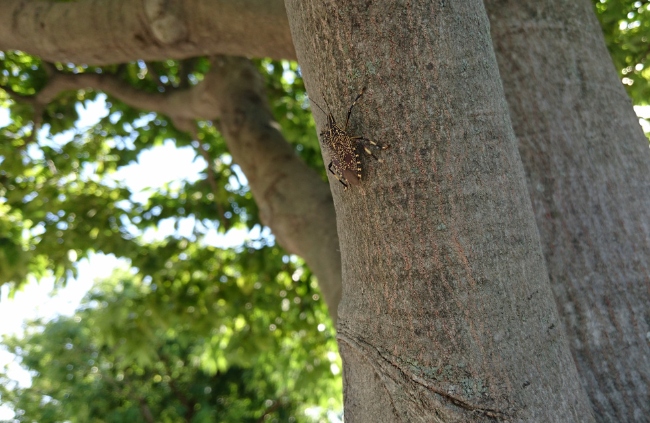
Are stink bugs harmful?
Stink bugs are not harmful to humans and won’t bite, but they can cause damage to fruit and vegetable crops and invade your home. Like all flying insects, they can rapidly spread bacteria onto food, but the risk is minimal.
What causes stink bugs inside the house?
Just like mammals, insects and bugs prefer not to be outside in cold weather. When temperatures drop, they instinctively look for warmth and shelter. Small cracks in brickwork, timber cladding or window vents allow stink bugs in.
How do you stop stink bugs from getting into your house?
Other than sealing up every possible entry point to your home (which is impossible) there is no real way to guarantee that you will not get stink bugs indoors in winter. But you can reduce their presence by placing a few drops of essential oils on potential entry points once a week.
What to do when you see a stink bug?
For the most part, just leave it alone. There is no reason to harm a stink bug when you see it. They are no danger to you, and rarely cause major damage to household vegetable patches.
Where do stink bugs lay eggs?
Stink bugs lay their eggs on the underside of leaves in dense clusters of up to fifty eggs. They are not picky about the type of plant they lay on.
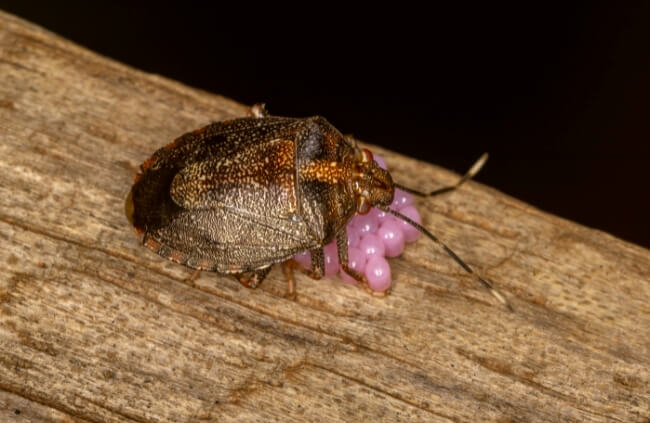
Is there any benefit of stink bugs?
Some species of stink bugs can deter other nuisance pest species, and will actually feed on them, so there is a legitimate case for looking after these weird little creatures. Predatory stink bugs eat everything from aphids to caterpillars.
Why should you not squish stink bugs?
Stink bugs release an awful odour when squished or when threatened, and the smell can stink on human skin and clothes for hours. And that is not the only reason you should not squish stink bugs!
That smell is not just meant to put off predators, it also attracts other stink bugs to them for help. So, if you squish one, there will be even more soon.
Do stink bugs fly?
Stink bugs fly better than most insects, despite their highly un-aerodynamic appearance. They have two sets of wings that fold out from their backs.
Are stink bugs beetles?
Stink bugs are not beetles, they are “true bugs”. Beetles are limited to the Coleoptera order of insects.
Wrapping Up Our Guide to Stink Bugs
Every pest in your garden has a purpose, and they are nearly all cleverer than we give them credit for. So, next time you see a stink bug, if it is just one… maybe leave it alone. It is not doing any harm, and if you harm it, it will probably have plenty of friends following behind. It is all part of the karma of gardening.
For commercial growers, particularly of citrus, there are definitely precautions to take, and arguments for and against pesticides, but try to be reasonably aware of beneficial insects if you need to get rid of stink bugs.
Published on December 27, 2023 by Gary Clarke
Last Updated on September 20, 2024

